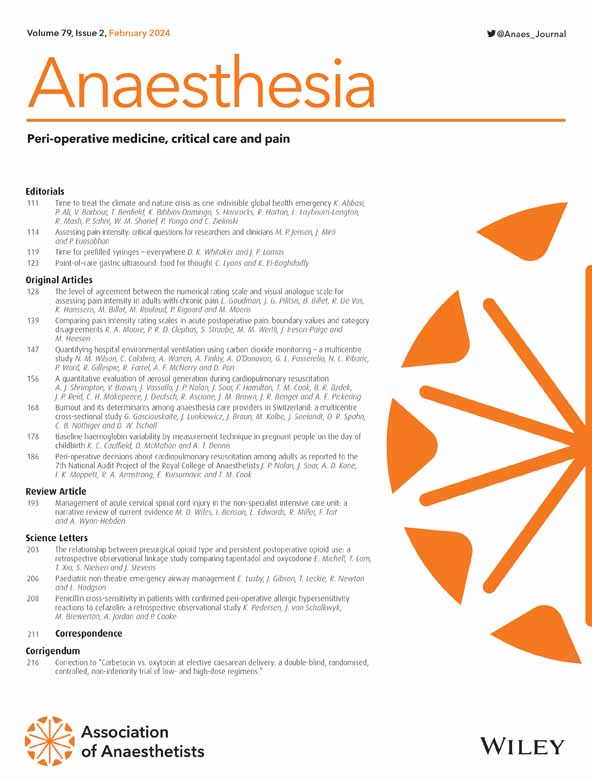Implementation of default videolaryngoscopy instead of direct laryngoscopy for tracheal intubation: a narrative review of evidence and experiences
IF 6.9
1区 医学
Q1 ANESTHESIOLOGY
引用次数: 0
Abstract
SummaryIntroductionDefault videolaryngoscopy – use of a videolaryngoscope in preference to a direct laryngoscope – remains a hotly debated topic. High‐risk tracheal intubations performed during the COVID‐19 pandemic added to the extensive existing evidence of advantages of videolaryngoscopy for patients and staff. Despite this, and calls for implementation of default videolaryngoscopy, it has not been adopted widely.MethodsWe summarise current evidence for the benefits of videolaryngoscopy and discuss (and where appropriate dispute) the common reasons given for not using videolaryngoscopy. The experiences of five UK NHS hospitals which have made a move to default videolaryngoscopy are described, with practical advice to assist other hospitals planning similar projects.ResultsSeveral recent large randomised controlled trials and meta‐analyses, incorporating data from over 200 trials, support the use of videolaryngoscopes. Guidelines and reports published since 2015 have recommended immediate access to videolaryngoscopes plus training and skill acquisition in the required techniques. Recent guidelines have recommended the routine use of videolaryngoscopes whenever possible. Reported advantages include: technical benefits (improved safety, efficacy and ease of tracheal intubation plus fewer complications); non‐technical benefits (including improved teamwork and communication); improved direct laryngoscopy training; and environmental benefits. Reasons cited for not using a videolaryngoscope include concerns that they: are unnecessary; lead to decay in or failure to learn direct laryngoscopy skills; videolaryngoscopy failure; ineffectiveness in a soiled airway; cost; and challenges relating to decontamination of reusable blades. We discuss these and, where appropriate, provide counter arguments.DiscussionThis narrative review provides the relevant evidence and information for clinicians, managers, procurement teams and sterile services departments to use, should a business case be proposed to implement default videolaryngoscopy. We describe effective practical strategies for addressing implementation challenges.实施默认视频喉镜检查代替直接喉镜检查气管插管:证据和经验的叙述性回顾
默认视频喉镜检查-使用视频喉镜而不是直接喉镜-仍然是一个激烈争论的话题。在COVID - 19大流行期间进行的高风险气管插管增加了大量现有证据,证明了视频喉镜检查对患者和工作人员的优势。尽管如此,并呼吁实施默认视频喉镜检查,它没有被广泛采用。方法我们总结了目前关于视频喉镜检查的益处的证据,并讨论了不使用视频喉镜检查的常见原因(以及适当的争议)。本文描述了五家英国国家医疗服务体系医院的经验,这些医院已经采取了默认的视频喉镜检查,并提供了实用的建议,以帮助其他医院计划类似的项目。最近几项大型随机对照试验和荟萃分析纳入了200多项试验的数据,支持使用视频喉镜。自2015年以来发布的指南和报告建议立即获得视频喉镜,并对所需技术进行培训和技能习得。最近的指南建议尽可能常规使用视频喉镜。报告的优势包括:技术优势(提高了气管插管的安全性、有效性和便利性,减少了并发症);非技术利益(包括改善团队合作和沟通);改进直接喉镜检查训练;还有环境效益。不使用视频喉镜的原因包括:没有必要;导致直接喉镜检查技能衰退或学习失败;videolaryngoscopy失败;在脏污的气道中无效;成本;以及与可重复使用刀片的净化有关的挑战。我们讨论这些问题,并在适当的时候提出反驳意见。本叙述性综述为临床医生、管理人员、采购团队和无菌服务部门提供了相关的证据和信息,以便在提出实施默认视频喉镜检查的商业案例时使用。我们描述了解决实施挑战的有效实用策略。
本文章由计算机程序翻译,如有差异,请以英文原文为准。
求助全文
约1分钟内获得全文
求助全文
来源期刊

Anaesthesia
医学-麻醉学
CiteScore
21.20
自引率
9.30%
发文量
300
审稿时长
6 months
期刊介绍:
The official journal of the Association of Anaesthetists is Anaesthesia. It is a comprehensive international publication that covers a wide range of topics. The journal focuses on general and regional anaesthesia, as well as intensive care and pain therapy. It includes original articles that have undergone peer review, covering all aspects of these fields, including research on equipment.
 求助内容:
求助内容: 应助结果提醒方式:
应助结果提醒方式:


